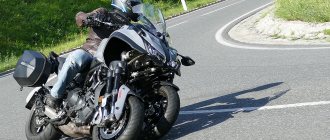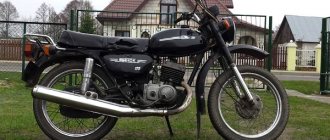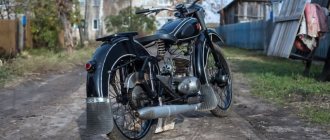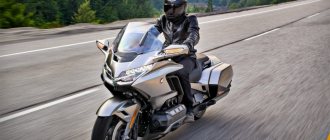Motorcycle Minsk D4 125 characteristics review
Minsk D4 125 produced at the Minsk-Moto plant. The model has a single-cylinder four-stroke carburetor engine with a power of 10.5 liters. strength The gearbox has five gears. The fuel tank has a capacity of 12 liters and is filled with fuel not lower than A-92. The engine starts using an electric starter, but there is also a kickstarter. The seat is covered with a special material protecting the motorcyclist from sliding off the seat. One thing to note about the brakes is that the front brake is hydraulic (disc) and is operated by hand. The rear block type is operated by the foot.
The ground clearance of the motorcycle is 210 mm. The front fork is telescopic. The rear suspension is pendulum with two shock absorbers. The front and rear wheels are the same size 3.00 by 18. The dry weight of the motorcycle is 100 kg. Maximum speed 100 km per hour.
The instrument panel and control switches are visible in the photo. In general, the motorcycle is not bad, cheap, affordable.
Return to contents — ↑
Now it’s impossible to believe it, but the history of motorcycles from the Minsk plant began in a dilapidated haberdashery factory in the capital of Belarus. In the autumn month of 1945, large-scale efforts began there to restore a few industrial buildings and auxiliary premises.The work was carried out in emergency mode, the country was in dire need of technical means of various profiles, and serious expectations were placed on the future plant. As soon as the production premises were put under the roof, the plant received the first deliveries of equipment and accompanying technical documentation from the engineering plant in the city of Zopau. In the confiscated drawings one could see the future Minsk motorcycle, the development history of which continues to this day.+
Subsequently, the plant, raised from the ruins, became a leading manufacturer of equipment, and its Minsk motorcycle, the history of the model of which is detailed in this article, acquired the meaningful epithet “Legendary.” The summer of '46 showed that there would be a plant! The first two workshops produced spare parts for the first bicycle of the Soviet country. Within a year and a half, the machine-building enterprise reached a production level of almost seven thousand units! In subsequent years, new brands of bicycle equipment for teenagers were developed - “Lastochka” and “Eaglet”.+
Since 1951, the plant in Belarus has been heading towards motorcycle technology, and then the Minsk motorcycle was born, the history of its models deserves special mention.
+
Motorcycle "M1M"
In 1956, the plant in Minsk produced a new M1M road truck. With its release, it completed the serial production of the technical model M1A, called “Moscow”. Thus, the history of motorcycle Minsk has been enriched with another rarity. The weight of the new technical development was 80 kilograms, which was especially liked by users of country dirt roads, who were no longer afraid of dirt and mud.+
In 1961, this model was replaced by the Minsk M101.+ motorcycle
Motorcycle M1A "Moscow"
From which source the Minsk motorcycle originates, the history of the M1A “Moscow” model shows most clearly. The M1A “Moscow” model motorcycle has become a real rarity of the plant. The history of motorcycles from the Belarusian manufacturer dates back to this single-seater model of 1951. The prototype of this technology was a motorcycle from Germany “DKW RT 125” - its drawings formed the basis of the first Minsk motorcycle. Not only the history of Minsk motorcycles began with a copy of German technology. The famous Kovrovets K-125 motorcycle, whose production was established in the Vladimir region, also resembled its German counterpart like two peas in a pod.+
For only one five-year period, motorcycles of the M1A “Moscow” model were produced at the Minsk plant. After this, in 1956, the production of a new, well-proven model M1M was launched. Ease of control, high reliability, reliability and cross-country ability - these are the distinctive features of the plant’s first in-house development.+
Motorcycle Minsk "M-101"
The beginning of the 60s was marked by a new development by Belarusian designers. This Minsk motorcycle history photo is very interesting. MMVZ started producing the Minsk M-101 motorcycle instead of the previously produced M1M model. The innovation of the development was expressed in the fact that the engine of the released model of equipment consisted of two 250 cc cylinders. cm. His weight was 130 kilograms. The Minsk “M-101” series of motorcycles did not receive a long-term perspective; the factory team limited itself to a small number of these models.+
It was replaced by the Minsk M-101 model and its successor, the M-103 model, whose engine was designed for 125 cc.
+
Motorcycle "Minsk M-103"
In 1962, the 250 cc Minsk M-101 motorcycle gave way to the new brainchild of Minsk designers - the M103 motorcycle. The Minsk Motorcycle Plant worked on the M103 model until 1964, when the technical thought of the factory specialists brought out the Minsk M104 motorcycle.+
Motorcycle Minsk "M-104"
Closer to the mid-60s, the Minsk Motorcycle and Bicycle Plant introduced the new “Minsk M-104”. With its appearance, it completed the production of the previous model “M-103”. Its weight was 90 kilograms, it could be loaded without exceeding 150 kg. The engine was 123 cc. had a power of 5.5 hp, it allowed a maximum speed of 75 km/h. The heating engine was cooled with air; for this purpose, purge from two channels was provided. "Minsk M-104" acquired a new effective muffler. The lightweight motorcycle had an improved appearance, which was enhanced by individual elements: next to the carburetor and in the seat part there was a trim panel, and on top there was a two-seater cushion seat. For three years, from 1964 to 1967, it was successfully produced, then it was replaced by the Minsk M-105.
+
Motorcycle "Minsk M-105"
In 1967, the Minsk Motorcycle and Bicycle Plant pleased all lovers of two-wheeled vehicles with the new M-105 motorcycle, which replaced the Minsk M-104. It embodied those improvements and modifications; they were made on the basis of an already produced motorcycle. The designers deliberately made it so that even a person far from technical could handle it. The speedometer now has bright backlighting, and a brake light has also been installed. A pendulum appeared on the rear wheel.+
Compact dimensions, high reliability, excellent maneuverability, good cross-country ability - very soon the motorcycle became a scarce commodity. Residents of the rural outback were pleased with the fact that spare parts for it were not difficult to find, and city residents also appreciated the motorcycle for its nimbleness.+
Motorcycle "Minsk M-106"
"Minsk M-106" MMVZ embodied the spirit of freedom that was in the air of the 60s. Another Minsk motorcycle, the history of the models continued in 1971. It was significantly different from its predecessor, the Minsk M-105 model, despite the fact that, in essence, it was its direct modification. The 123 cubic centimeter engine had a power of 9 horsepower at 5.5 thousand rpm. The fuel tank of the motorcycle was designed for an increased volume of the combustible mixture - 12 liters. The model, released by the plant in 1971, developed a maximum speed corresponding to 85 km/h.+
The company's designers paid special attention to technical design and comfort. In addition to the fact that the new motorcycle acquired an attractive appearance, it received a significant advantage for those times - a trunk, which Soviet buyers loved so much that it was decided to introduce this innovation as standard equipment for this and all subsequent models. +And again the Minsk history of motorcycles has been enriched with yet another development. In 1973, the “Minsk M-106” was replaced by the creation of the factory design engineers - the M-106 motorcycle.
Motorcycle "MMVZ-3.112"
1980 opened a new decade and marked the beginning of the production of a new model of motorcycle equipment - the MMVZ-3.112 motorcycle. The Minsk Plant has supplemented the MMVZ model range of two-wheeled vehicles with another development, which replaced the Minsk MMVZ-3.115 model. The new technology has become truly universal; it moved with equal success both on the highway and in other areas.
+
How did the MMVZ-3.112 model differ from the previous ones?
The engine of the MMVZ-3.112 model accelerated at 95 km/h and had a power of 12 horsepower. Drivers who love comfort will immediately notice the comfortable seat with increased width. The spokes in the wheels became wider and more substantial, while their length decreased, due to which the wheels acquired additional rigidity. There was one cylinder of 123 cubic centimeters providing it with excellent running properties. The cylinder has aluminum fins that hide the built-in inner sleeve.+
This design move contributes to the most efficient cooling of the engine, regardless of the ambient temperature. The MMVZ-3.112 model was produced at the Minsk plant until 1984. Subsequently, the motorcycle was modernized by factory designers, and the result of their work was a new production model - MMVZ-3.112.1.
+
Motorcycle "MMVZ-3.115"
MMVZ-3.115 became the flagship product of the Minsk plant in 1976. The predecessor of the middle class motorcycle MMVZ-3.115 was the factory development of the MMVZ-3.111 model. The MMVZ-3.115 model received the short name “Minsk”; its weight was 112 kg. The motorcycle was equipped with a K-62S carburetor. It operated on a mixture of oil and gasoline, fuel consumption was 4 liters per 100 km. 12 liter tank. Very soon this motorcycle model earned a reputation as a technique.+
1980 marked the end of the production of the MMVZ-3.115 motorcycle model and gave rise to a new technology - the MMVZ-3.112 motorcycle.
+
Motorcycle "MMVZ-3.111"
In 1973, the Minsk Plant presented its new development - the MMVZ-3.111 model. The light motorcycle accelerated to 90 kilometers in a short time. Despite the fact that the equipment was in high demand in the Soviet country, its production was discontinued after 3 years. This was due to the fact that the MMVZ-3.111 model underwent a number of changes, which gave rise to a new improved version - MMVZ-3.115.
Like the Minsk motorcycle itself, the history of the development of the manufacturing enterprise also dates back decades. But the tradition continues in our time. But the traditions and history of the Minsk Motor Plant continue in our time. The new model MMVZ-3.113.5, called “LEADER”, was introduced to the market in 2003. Designers from Belarus paid special attention to the appearance of the motorcycle - it turned out to be truly presentable and modern.+
At the same time, technical improvements to this model began, which acquired such proportions that the modernized version received its own serial number MMVZ-3.114. The new motorcycle is equipped with a five-speed gearbox. This equipment is produced for export.+
Today, the plant produces a cargo modification of motorcycle equipment - the S-3.901 cargo motorcycle. The next generation models have also been launched and are equipped with 200 cc four-stroke engines. see+
Now the Minsk Plant has developed partnerships with foreign manufacturers, which provide for cooperation in the development of new generations of modern ones.+
This is where the history of motorcycles from the Minsk plant ends. As you learned, she went through a difficult path to perfection. But nowadays it produces some pretty good motorcycles.
Video courtesy of Garage BFS channel
Motorcycle Minsk R250
Minsk R250, twin brother of Megelli 250R, the only difference is the brand name on the side. But it is worth noting that Minsk is assembled in Belarus, and its clone in China, although it was designed in Europe.
Minsk is ready for sports driving, and can prove it exactly as much as the pilot demands. And all this thanks to the rigid “birdcage” frame. For drivers taller than average, it will be inconvenient to hide their knees; the side fairings are not designed for tall drivers.
The device is quite decent for clearing traffic jams in the city. But don’t forget about the non-adjustable fork and rigid monoshock, because of which on the roads that are typical for all of us, you can get a good blow to the “butt” or shake your hands.
The 250 has very good brakes, which was a pleasant surprise. But with tires things are much worse. No, you can drive on standard tires, but not more than 60 km/h. The manufacturer, of course, promised to take action. The engine runs smoothly, without failures. I would like some pickups, but alas. 6000-7000 rpm, in this range it produces all its power.
Return to contents — ↑
M-103 or “Take it, otherwise it’s hard to kick the ducklings out from under it)))
It was a long time ago and it’s not true))) Although no, it’s true.
While still at school, I somehow miraculously had the opportunity to ride on a classmate’s moped, in my opinion Riga-11, and from that moment it all began. By hook or by crook, I tried to convince my parents that a moped was good and that I really needed it, at some point I succeeded and I finally got the treasured, two-speed moped Riga-3, in a bag))). After fiddling with it for about a year and without really driving it, I sold it to the delight of my parents. By the way, they are motorcyclists, in their youth they rode all over the USSR, but when talking about the motorcycle they were categorically against it, saying that a lot of friends were beaten.
So probably a whole year passed, but one day, on another summer day, sitting at the table, my father said: “And I bought a motorcycle...”. Happiness knew no bounds, we went to pick him up. We arrived and were greeted by an old, gnarled granny who, when asked about the price of the motorcycle, waved her hand and said: “Take it like that, it’s hard for me to kick the ducklings out from under it!” and while Father persistently forced Granny to take at least some money and humanitarian aid in the form of food, I could not resist and went to see what kind of beast was there, covered in rubbish. There are no photos of what kind of motorcycle it was, it wasn’t fashionable then or something))). It was a motorcycle from the Minsk Moto-Velo Plant, model 103, 125 cc, 3 speeds, according to various sources, 5 or 7 horses.
After the words that the grandchildren broke and abandoned the motorcycle a long time ago, it was placed in the back of an onboard UAZ and taken home to the garage. Looking at the pile of rubbish that we brought, my mother stopped worrying)))
Slowly gathering together what fit together, it was decided to try to start this device by pouring gasoline into the tank, shaking out the dead flies from the carburetor and pushing this monster down the street a little, it started! It started smoking and off it went! Having stood for about 20 years!
Well, since the patient was more alive than dead, restoration work began. At that moment, he was simply required to ride, collecting it in a heap, changing everything that had rotted and decomposed, rebuilding the engine a couple of times, I rode this motorcycle throughout my youth. And it so happened that this monster was always in good order and it always “was”, although it did not represent any value. All sorts of IZHs, JAVs, CheZets and the like were bought and sold, and this friend always stood in the garage and was a spare. Sometimes, by luck, when all sorts of parts from a given motorcycle were found in landfills, garages, scrap metal collection points, these parts were bought out and put aside in the “far corner”.
Then school ended, then military school, graduation, in short, “more and more,” and 10 years later, while on another vacation in my native land, rummaging around in the garage under a cover, I discovered an old friend of mine. There could be no other solution. Restore! Although at that time it was far from the first “Japanese” in the stable))), especially since in 2012 it officially became a “rarity”)))
It was not possible to preserve the original paint and therefore the motorcycle was completely disassembled, sent to the paint shop, all the “chrome parts” were sent to the factory, the engine was rebuilt, and most of the parts were found new. A lot of things were sharpened by very good people who were inspired by the idea of restoring this unit, with such equipment that Honda could not even dream of))), hoses, rubber bands, cables and the like, the documents were made anew, even the old numbers were left. And the result was this motorcycle called MMVZ-103 or “Douglas” as his friends called it, a respectable 54 years old, wrapping another decade on its wheels. But only on holidays)))
Tags
- Minsk
- MMVZ
Motorcycle Minsk 103
The Minsk 103 motorcycle is a further modernization of the M1M motorcycle. It differs from the latter mainly in the design of the chassis.
The installation of a front telescopic fork and a rear suspension with hydraulic shock absorbers (see motorcycles K-125M and K-55) significantly improved the smoothness of the motorcycle. The electrical equipment and ignition system on the M-103 motorcycle are made according to a scheme similar to the M1M motorcycle; the exception is the G 401 generator (instead of G-38 and G-37).
Return to contents — ↑
Motorcycle M1M Minsk - overview of characteristics
The M1M is similar in engine and power transmission design to the M1A and K-125, but differs in the design of the front fork.
The M1M has a front wishbone fork. Pipes 1 of the right and left fork stays are secured in the upper and lower bridges with clamps secured with bolts. A steel box-shaped tip is welded to the lower end of the pen tube. There is a spring 2 in the feather tube. In the walls of the tip on the horizontal splined shaft 6 there is an outer lever 10, in the disk of which the wheel axle is mounted, and an inner lever 5, which rests against the spring through a pusher 4. The friction shock absorber consists of one movable disk 16 mounted on a splined shaft and two fixed steel disks 17, between which friction washers 21 are installed. The disks with washers are compressed by the spring 20 of the shock absorber cover 19. The shocks received by the wheel through the outer lever 10 of the wheel, the splined shaft 6, the inner spring lever 5 and the pusher 4 are perceived by the spring 2 of the blade and partially by the shock absorber. To prevent hard impacts, the feather has lower 7 and upper 22 rubber buffers. The shock absorber is adjusted by tightening the cover 19.
As a rear suspension, the M1M is equipped with a lever spring suspension with a friction shock absorber. The wheel axle is installed in the eye of the swinging rear fork; Between it and the fangs welded to the stationary part of the rear fork, hinged spring suspension elements are installed, covered with telescopic casings with a seal. Parallel to the spring element, the levers of a double-acting friction shock absorber with adjustable resistance are connected to the tusk and to the ball ring on the oscillating fork.
Since October 1954, electrical equipment with a G-37 alternator and an FG-17 headlight has been used in Minsk. Installed instead of a G-35 DC generator and FG-3 headlights. The ignition coil, signal, low and high beam switch, rear light and battery are used from the previous M1A electrical equipment set.
Return to contents — ↑









